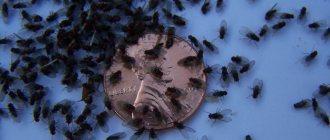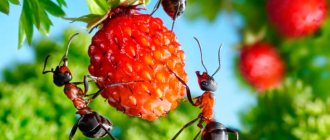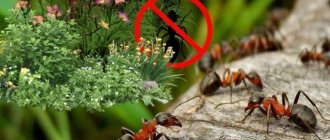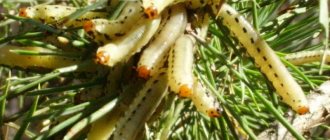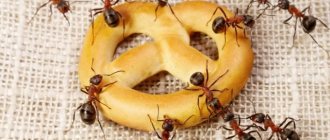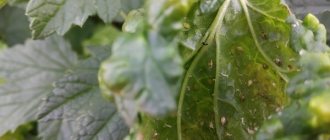The question of how to get rid of ants in the countryside worries every gardener. You can cope with the problem yourself using professional or folk remedies.
The article contains useful tips and popular methods that will help drive ants out of your summer cottage.
Ants in a summer cottage are a common problem that you can deal with yourself using folk remedies or insecticides
You cannot get rid of ants with 100% certainty: there are no guarantees, they will still come back.
Ants in the country: benefit or harm
The appearance of anthills in the countryside is the first sign of a potential danger to the plantings. The reason for this is the colonies of aphids and mealybugs, which the ants breed for their own food. They not only contribute to the development of insect pests, but also protect them from potential enemies - ladybugs, predatory bugs, ichneumon ichneumon wasps and others.
Small anthill Source mtdata.ru
Interesting! Numerous colonies of aphids cover all the ant's efforts related to the destruction of small caterpillars and larvae of other garden pests.
The answer to the question of how to deal with ants in a dacha sooner or later confronts the owner of a garden plot. There are two ways to solve the problem:
- Destroy the anthill and its inhabitants.
- Relocate or force small neighbors to move to another location.
What plants do garden ants not like?
This is probably the simplest and most ingenuous way to forget about ants: plant plants whose smell they cannot stand:
- Parsley;
- Tomatoes;
- Mustard;
- Mint;
- Onion;
- Marigold;
- Garlic;
- Carnation.
Some plants can be grown for harvest, and at the same time make an excellent ant repeller. Others - we grow them as garden decorations
Types of ants
- Red wood ant (Formica rufa)
Most often they live in the forest, but sometimes they also settle in summer cottages, on the boundary between vegetable gardens. The species is already listed in the Red Books of Moscow, Voronezh, Kostroma, Lipetsk, Novgorod and Chelyabinsk regions.
Benefit . These insects are the orderlies of the forest and garden. One anthill clears a quarter of a hectare of forest or garden from pests. In Europe, red forest ants are artificially dispersed.
Harm . Aphids are actively bred. Secondly, they spread the seeds of wild plants - these are weeds.
- Black garden ant (Lasius niger)
Benefit . Destroys pests. But not all, but only the smallest ones.
Harm . Aphids are bred. They eat strawberries.
- Garden pale-legged ant (Lasius alienus)
Benefit . They eat pests.
Harm . Aphids are bred. They eat strawberries.
- Red myrmica (Myrmica rubra)
Benefit . Omnivores, destroy garden and garden pests.
Harm . Aphids are bred. They bite painfully.
- Black carpenter ant (Camponotus vagus)
Benefit . They eat harmful insects. They do NOT breed aphids - that is, they are practically harmless to the garden.
Harm . They eat fruit, although not often. Therefore, the harm is minimal.
- Pharaoh ant (Monomorium pharaonis)
The most common. These are the insects that live in houses. They prefer dark, warm and humid places.
Benefit . Absent.
Harm . They eat food. They can be carriers of infections in the same products. They can crawl into the ear at night.
Where do ants come from in the garden?
Forest ants come from the nearest forest. They do not stay in the garden for long, but in the evening they always return to the anthill. Garden ants settle directly in the garden: in a rotten stump, under tree roots or in the ground, sometimes right in the beds. They usually come from neighboring plots of land.
These tenacious insects constantly migrate in small groups from place to place in search of food, and when they find a suitable territory, they settle on it. The abundance of edible plants contributes to their high fertility. These insects build multi-level underground nests in which they feel comfortable in any season of the year. If you do not remove the ants from the garden bed before the onset of autumn, they will successfully overwinter and again begin to cause trouble in the spring.
How to destroy an anthill
The most humane way to “destroy” an anthill in the garden:
- Dig it out along with the soil.
- Carefully place in the bag.
- Move them to another place where their colony will not harm anyone.
Other options do not have this attitude. You will have to stir up the nest, water (sprinkle) with something (purchased chemicals or prepared from improvised means). Some actions will lead to the death of insects, others to relocation, in any case, the goal will be achieved.
Safety precautions
When using all types of drugs or folk remedies, be sure to remember the safety rules:
- When carrying out processing, it is necessary to use protective gloves and, if necessary, a respirator.
- During work, you must not consume food or drinks.
- Baits should be placed in places protected from children and pets.
- When preparing solutions, do not use containers used for food purposes.
- All spraying and treatments are carried out only in dry, calm weather.
- Upon completion of work, hands must be thoroughly washed, clothes and shoes washed.
- You should always carefully read the labels and manufacturer's recommendations, observe the specified waiting period, during which you should refrain from contact with the treated surface. After using insecticides, it is necessary to strictly observe the deadlines for manual work.
Compliance with the rules listed above will avoid poisoning and other unwanted side effects.
Attention! Any chemicals used in the garden can affect our immediate environment. Their use must be taken into account, especially when children and animals (dogs, cats) live in the house. Chemicals also affect crops (vegetables, fruits) and other insects (for example, beneficial pollinators - bees).
Ants are one of the most common garden pests. Without timely treatment, their colonies quickly spread throughout the area, causing serious damage to various crops.
Folk remedies
The most popular and effective time-tested methods of fighting ants in the garden.
Water the anthill with water and kerosene Source felisov.ru
Stir up the anthill and pour boiling water over it. Repeat the procedure for several days. Instead of boiling water, you can use other alternative products that are easy to find in your country house: soap solution, dishwashing detergent, vegetable or essential oil, table (9%) vinegar, kerosene, ammonia. The listed compositions are mixed with water, which is poured into the anthill and places where insects accumulate. When entering the house, wipe the liquid on door and window openings, ventilation openings and other places through which they can get inside.
We force the ants to move Source fotokto.ru
Ants prefer to settle in sunny areas. By building a temporary shade over the nest, you will force them to move to another place.
Advice! If the anthill is built next to garden plants, move the insects to another place. To do this, place rags soaked in any of the listed liquids next to it.
Preventive actions
The difficulty of removing unpleasant neighbors requires preventive measures. First of all this:
- Maintaining cleanliness.
- Timely removal of garbage.
- Wipe surfaces with a damp cloth.
- Storing food in airtight containers.
- Sealing joints.
You need to be aware of the appearance of “aliens” in neighboring apartments in order to prepare for a decisive defense.
Cleanliness is a guarantee that you will not encounter this problem. If all methods are unsuccessful, contact the pest control service. Processing with special means will end with the complete defeat of small usurpers.
Boric acid
Boric acid is an old and proven method of fighting ants. It has a contact-intestinal effect on insects. It destroys it simply by getting on the insect’s cover, without penetrating the intestinal tract. Even the smallest proportion, mixed with a sweet filling (sugar, honey) and brought by the hunter to the nest as a trophy, will eventually lead to the complete extinction of the entire genus. Sold in pharmacies, sold in the form of crystalline powder or alcohol syrup. The bait is placed around the anthill, on the ant trail.
Boric acid is the enemy of the ant Source stopklopu.com
Below are several ways to prepare poisonous compounds:
| Name | Ingredients, proportions | Nuances, cooking process | Procedure |
| Yeast | Sugar – 25 g. Water – 40 ml. Yeast – 1 tbsp. Boric acid – 10 g. | First, the syrup is prepared, then yeast is added and the poison is poured in. | Add something sweet (vanillin, honey), pour it into a plastic plate and place it near the anthill. |
| Sugar | Sugar – 50 g. Water – 150 g. Boric acid – 1 sachet. | Sugar is mixed in water. | Sweet syrup is used to attract insects; acid crystals scatter around. |
| Egg-honey | Egg yolks – 3 pcs. Honey – 1 tbsp. l. Boric acid – 1/3 sachet | Mix boiled yolks with poison crystals, add honey. Mix and roll into balls no larger than a walnut. | The balls are laid out next to the anthill, on the path. |
| Potato | Potatoes – 3 pcs. Egg yolk – 3 pcs. Boric acid – 1 sachet | Crumble and mix the boiled yolks with the potatoes. Add acid. The composition should resemble mashed potatoes; to achieve the desired consistency, add water. Roll into hazelnut sized balls. | The balls are placed in places where insects accumulate. |
| Bread | Bread – 1 slice Honey – 1 tbsp. l. Boric acid – 5-6 drops of liquid 3% solution | Mix bread pulp with honey, add acid solution. Form small balls. | Place the balls near the anthill. |
| Glycerin-honey | Pharmacy glycerin – 3 tsp. Water – 1.5 tbsp. l. Honey – 2 tbsp. l. Sugar – 2 tbsp. l. Boric acid – ½ sachet | Mix the ingredients until smooth. You should get a plasticine-like mass from which you can roll into small balls. | Place the poison next to the ant nest. |
Important! Boric acid is a strong poison for both insects and humans. Prepare baits strictly with rubber gloves. Do not increase the dose, otherwise the foraging insect will die before it has time to bring the crystal to the anthill.
We force you to relocate
Knowing the sensitivity of ants to pungent odors, you can create “unbearable conditions” for them and force them to leave their “habitable” place. For this you may need the following plants:
- Mint.
- Mustard.
- Tansy.
- Anise.
- Parsley.
- Dill.
- Rhubarb.
Counteraction using fragrant herbs Source freepng.ru
How the listed varieties will be used does not matter. They can be planted in places where insects gather, or scattered dry or withered.
Wood ash, ground cinnamon, any type of pepper (seasoning), or anything else that emits a pungent odor are considered analogous flora representatives in the fight against ants.
Working day of an insect Source pestnews.ru
Important! Ants do not like strong odors. After treatment with the listed compounds, the insects leave the anthill and go to a new place.
Aromatization
You can seriously scare off uninvited guests:
- Anis;
- Turpentine;
- Elderberry leaves;
- Citrus zest;
- Birch tar;
- Mint;
- Cinnamon and cloves.
They also do not like the aromas of essential oils, bay leaves, and coffee grounds.
Chemicals
Let's consider a list of effective chemicals that effectively help in the fight against ants. Below is a brief description and characteristics of the substances; instructions for use for each of them are individual and printed on the packaging.
"Muravyin G"
Russian granules “Anteater G” Source udobreniya.info
Any garden store can offer several insecticides with the same name, produced in Russia and abroad. Here we are considering a domestic drug, the packaging of which is shown in the photo. When used in accordance with the manufacturer's instructions, it is safe for humans, bees and other vertebrate inhabitants of the country garden. Refers to substances of the lure, directional type. Sold in the form of granules intended for dissolution in water.
"Ant-eater"
Available in different types:
- Concentrated emulsion "Aardvark CE" in ampoules of 1 ml. or bottles of 10, 50 or 500 ml.
- "Anteater - Super, granules." Small granules, packaged in 50 g bags or 120 or 240 g jars.
- “Anteater – Super, bait” is packaged in plastic bags with ready-made bait.
- "Anteater - Super, gel." Sold in tubes, in the form of a gel.
“Anteater” from garden ants Source yaplakal.com
The insecticide has high enteric-contact activity and gives the first results in 2-3 days. Valid for 3 weeks. If you follow the instructions for use, it is not dangerous for representatives of the flora. The average consumption is no more than 1.5 ml per anthill.
Store options
Chalk “Mashenka”, gel “Raptor”, “Storm”, “Fas” have become widespread, which are applied with a dotted line in the sectors of movement of ants, and they carry poison into the nests, infecting the entire population, including the larvae and the queen.
Many users prefer powders and granules:
- Karbofos,
- Thunder,
- Antimuravyin,
- Hector, acting in the same way.
- All products are made on the basis of Chlorpyrifos and Diazinon, which cause paralysis of the nervous system.
It is advisable to operate with insecticides in extreme cases when popular recommendations have not helped. It is necessary to strictly follow the manufacturer's instructions and work in a respirator, goggles and gloves.
Lures and traps
The following methods help you win the fight against ants without using chemicals. Similarly to folk methods, they are classified as proven and bring quick results. Their goal is to create simple traps where insects get trapped and cannot escape. All you have to do is update them periodically as they are filled out. Baits involve the preparation of compounds that lead to the death of insects.
Shop catcher belts for garden trees Source potrebitel.ru
The most promising actions in the fight against ants in the country:
- Place a mayonnaise bucket with 2-3 teaspoons of sugar diluted in water in places where insects accumulate. The ants will crawl towards the sweets, but will drown in the water. It will not be possible to completely destroy the population, but it is possible to reduce the number.
- Place yeast diluted in water with added homemade jam or sugar next to the anthill. Particles of the bait will be carried inside the anthill, which will cause the formation of fungus and the destruction of working individuals. At the first stage, it may seem that there are more insects, but this is due to the fact that they will crawl onto the sweet bait.
- Another, no less effective method allows you to scatter dry balls of granules around or roll larger ones from fresh ones. There is no need to mix with water; the effectiveness is similar to the previously described method.
- Millet or semolina mixed with sugar for bait. Working ants eat enough, the cereal swells and kills them. Then the uterus and the eggs left without care die.
Methods for destroying the queen ant
The family of these insects represents a clearly organized hierarchical structure. The queen leads the colony. Its only purpose is oviposition. It significantly exceeds the size of working individuals. It has a large abdominal oviparous organ and massive chest with a well-developed muscular system. The lifespan is about 20 years, which is longer than the biological existence of any other ant.
Destruction of the queen is a key condition for getting rid of the entire family. She lives deep in the depths of the anthill and never comes to the surface. In large polygynous colonies there are two or more queens. To destroy it, the methods described above for deep influence on the anthill are suitable - from boiling water, ammonia, ammonia and borax to potent insecticides.
Attention! Removing the queen does not provide a 100% guarantee of getting rid of the ant family. In a large-scale nursery there are several of them. Before death, she may have time to lay eggs. Among the new brood, it is possible that a queen will appear, which will again begin to actively increase the number of pests.
How to deal with ants on fruit trees
The harm from aphids and mealybugs bred by ants is obvious. You can avoid their occurrence in two ways: equip a trap or barrier belt, spray the plant. Be sure to sprinkle the soil around the plants with ash mixed with table salt at the beginning of the season. By doing this, you will not only prevent ants from entering, but also replenish the soil around the tree with useful potassium.
Carry out periodic inspections throughout the season. If necessary, use one of the following measures:
- If you find aphids, the juice of which is so attractive to ants, treat the tree with compounds that destroy this insect.
- Make an ant-repellent headband. To do this you will need table salt, linseed oil and soot. After mixing the listed elements, rub the lower 30-40 cm of the trunk with the resulting composition.
- You can temporarily repel insects by rubbing the tree trunk with garlic or placing cloves of garlic at the base. It is possible to replace it with one of the previously listed components, the pungent smell of which repels ants (wormwood, mint, mustard, rhubarb, dill).
Protecting trees from ants with your own hands Source stopklopu.com
Headbands against ants Source felisov.ru
Varieties
There are several types of ants: forest, red (brown), red and black (garden). The last species is a real pest of its forest counterparts. They make an anthill out of a small hole in the soil, with a hill on top of it. Under your feet you can see the homes of individuals around trees and in the roots. The red species is also called pharaonic. When they appear on the site, almost all plants suffer. The difficulty lies in destruction, because insects quickly restore the number of their offspring and get used to the chemicals.
Pests parasitize the root system, causing the death of the plant. Even if the ants’ home appears in the garden, not in the roots, nothing will grow in these places.
